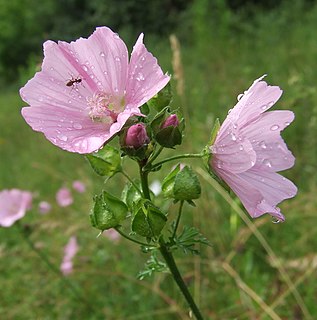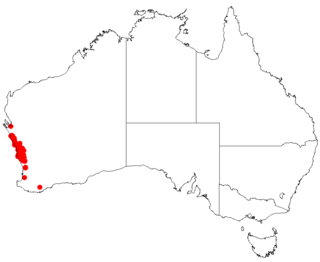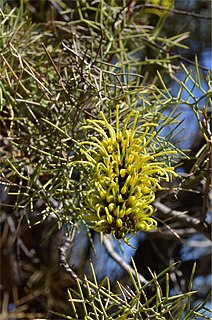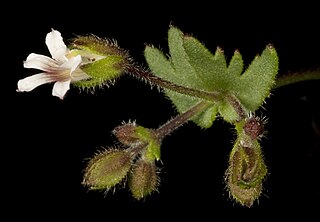
Malva moschata, the musk mallow or musk-mallow, is a species of flowering plant in the family Malvaceae, native to Europe and southwestern Asia, from Spain north to the British Isles and Poland, and east to southern Russia and Turkey. Growing to 60 cm (24 in) tall, it is a herbaceous perennial with hairy stems and foliage, and pink saucer-shaped flowers in summer.

Senecio angulatus, also known as creeping groundsel and sometimes as Cape ivy, is a succulent plant from the family Asteraceae of the genus Senecio that is native to South Africa. It is a scrambling and a twining herb that can become an aggressive weed once established, making it an invasive species in some countries. However, it is grown as an ornamental plant for its satiny foliage and sweet-scented flowers.

Isopogon dubius, commonly known as pincushion coneflower, is a species of plant in the family Proteaceae and is endemic to the south-west of Western Australia. It is a shrub with sharply-pointed, deeply lobed or pinnate leaves and more or less spherical heads of pink to reddish pink flowers.

Olearia phlogopappa commonly known as the dusty daisy-bush or alpine daisy-bush is a species of flowering plant in the family Asteraceae that is commonly found in eastern New South Wales, Victoria and Tasmania. It is a small shrub with greyish-green foliage, daisy-like flowers in white, pink or mauve that can be seen from spring to late summer.

Hakea decurrens, commonly known as bushy needlewood, is a species of shrub or small tree in the family Proteaceae.

Persoonia silvatica, commonly known as the forest geebung, is a plant in the family Proteaceae and is endemic to south-eastern Australia. It is a shrub or tree with more or less lance-shaped leaves and small groups of yellow flowers with white centres. It grows mainly in forest near the border between New South Wales and Victoria.

Eremaea fimbriata is a plant in the myrtle family, Myrtaceae and is endemic to the south-west of Western Australia. It is a small shrub with small leaves and single purple flowers on the ends of the branches. The fruits are woody, urn-shaped with a small opening at the top. Unlike other eremaeas which remain dormant during winter, Eremaea fimbriata begins the new year's growth in July or August.
Calothamnus roseus is a plant in the myrtle family, Myrtaceae and is endemic to the south-west of Western Australia. It is a shrub with needle-shaped, prickly leaves and pink flowers with four stamen bundles.
Persoonia manotricha is a species of flowering plant in the family Proteaceae and is endemic to Western Australia. It is an erect shrub with hairy young branchlets, more or less cylindrical leaves and greenish yellow flowers in groups of up two to eight on a rachis 2–15 mm (0.079–0.591 in) long. It is similar to P. bowgada and P. hexagona but has longer pedicels than P. bowgada and differently grooved leaves from P. hexagona.

Isopogon baxteri, commonly known as the Stirling Range coneflower, is a species of plant in the family Proteaceae and is endemic to the south-west of Western Australia. It is an erect shrub with wedge-shaped, often 3-lobed, toothed leaves and flattened spherical heads of hairy pink flowers.

Hakea auriculata is a reasonably common shrub in the family Proteaceae endemic to Western Australia. A very showy species in full bloom with creamy white, yellow, dark red or reddish purple fragrant flowers.

Hakea actites, commonly known as the mulloway needle bush or wallum hakea is a shrub or tree of the Proteacea family native to areas in north eastern New South Wales and south eastern Queensland. White nectar rich flowers appear in abundance from late autumn to early spring.

Hakea divaricata, commonly known as needlewood, corkbark tree or fork-leaved corkwood, is a tree or shrub in the family Proteaceae native to an area in central Australia. A slow growing species with up to 120 showy cream to greenish-yellow flowers in long racemes from June to November.

Hakea kippistiana is a shrub in the family Proteacea and endemic to Western Australia. It is a dense prickly shrub with sharp needle-shaped leaves with fragrant white, cream or pink flowers from November to February.
Verticordia luteola is a flowering plant in the myrtle family Myrtaceae, and is endemic to the south-west of Western Australia. It is a more or less openly branched shrub with crowded leaves on its side branches and spikes of pale yellow or bright pink flowers which turn cream to brownish as they age. This verticordia is a summer-flowering species.

Tephrosia glomeruliflora, or pink tephrosia, is a perennial (non-climbing) herb in the family Fabaceae, endemic to South Africa. It is also found on the eastern coast of Australia, in New South Wales and Queensland, where it is considered an environmental weed.

Scaevola basedowii is an erect multi-stemmed shrub in the family Goodeniaceae, endemic to Western Australia, the Northern Territory and South Australia.

Caladenia rosea, also known as pink primrose orchid, is a plant in the orchid family Orchidaceae and is endemic to relatively inaccessible, high lateritic plateaux in a high rainfall area in south-western Western Australia. It is a terrestrial orchid with a single hairy leaf and up to three pink flowers on a thin, sparsely-hairy stem. It is similar to Caladenia flava but is distinguished by the perianth being pink to dark pink with prominent red striping and spotting on the dorsal sepal and lateral petals. Caladenia rosea mimics Hypocalymma robustum (Myrtaceae) in terms of flowering time, colour and scent.

Androcalva rosea, commonly known as Sandy Hollow commersonia, is a small endangered shrub with pink flowers and prostrate trailing branches. It is only known from four locations in the Hunter Valley of New South Wales.

Goodenia cycnopotamica is a plant in the Goodeniaceae family which is endemic to Australia, and found in both South Australia and Western Australia


















